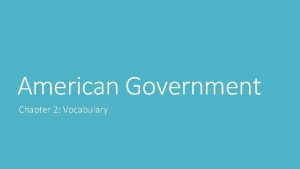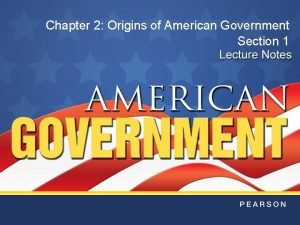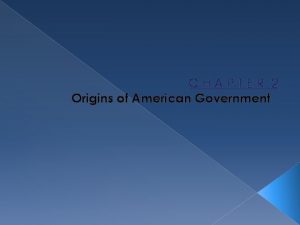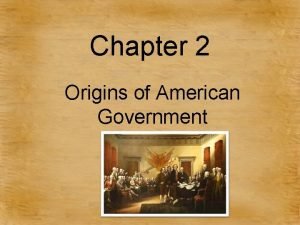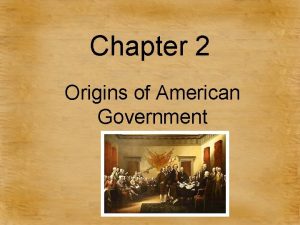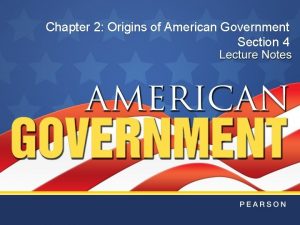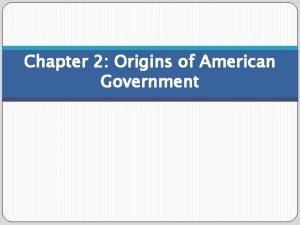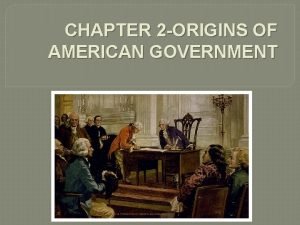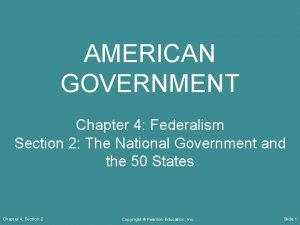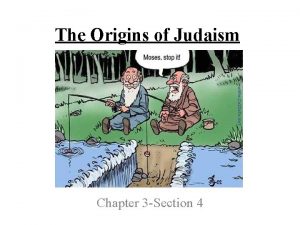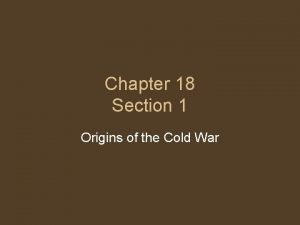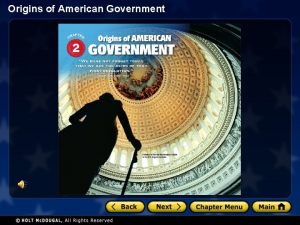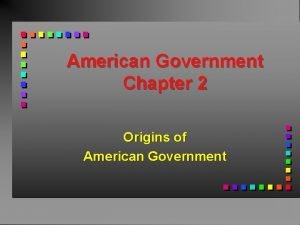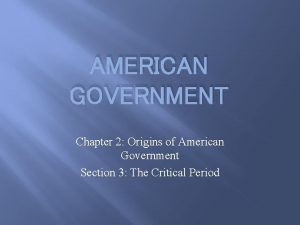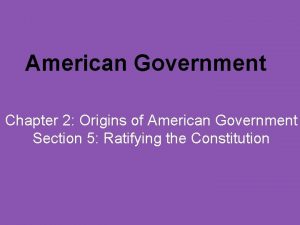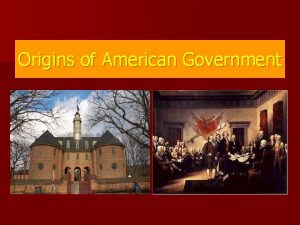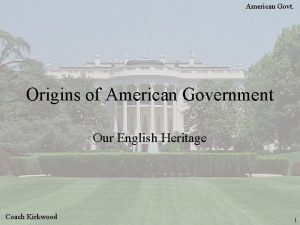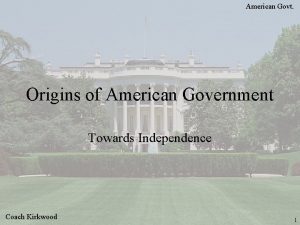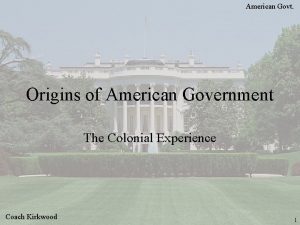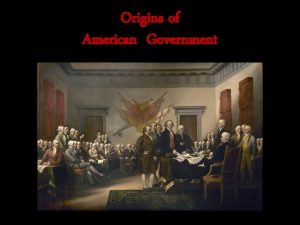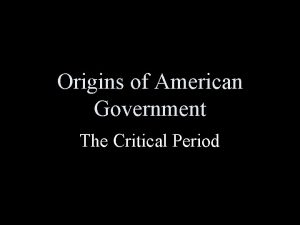Government Povletich Chapter 2 Origins of American Government













- Slides: 13

Government (Povletich) Chapter 2: Origins of American Government Section 1: Our Political Beginnings English and Colonial Political Ideas

Reading Guide Section 1: Our Political Beginnings As you read, answer the following questions. 1) What is ordered government? 2) What is limited government? 3) What is representative government? 4) How did the Magna Carta affect English government? 5) How did the Petition of Right affect English government? 6) How did the English Bill of Rights affect English government? 7) How were royal colonies governed? 8) How were proprietary colonies governed? 9) How were charter colonies governed? 10) Define CHARTER: 11) Define BICAMERAL: 12) Define UNICAMERAL:

Section 2: The Coming of Independence Timeline In the space provided, write a description of the event that happened on the date given 1643 1696 1754 1765 1770, March 5 1772 1773, Dec 16 1774, Spring 1774, Sept 5 1775, April 19 1775, May 10 1776, June 7 1776, July 2 1776, July 4 1781, March 1 Define DELEGATES: Define CONFEDERATION: Define REPEAL:

Section 3: The Critical Period Articles of Confederation Strengths Weaknesses • Make ______, and ________ • ____ vote per State, regardless of _____ • Send and receive _________ • Congress ________ to lay and collect _____ or duties, or to regulate ______ trade and ______ commerce • Borrow _____ and set up a money system • Establish __________ • Build a ____ and raise an _____ • Fix uniform _______ or weights and measures • Settle _____ among the States • No _______ to enforce the acts of Congress • No national _____ system • Amendment only with consent of _____ States Consequences • • •

Section 3: The Critical Period The Articles of Confederation 1. Describe the structure of the government set up by the Articles of Confederation. Congressional Powers Under the Articles of Confederation 2. _____________ 7. _____________ 3. _____________ 8. _____________ 4. _____________ 9. _____________ 5. _____________ 10. _____________ 6. _____________ 11. _____________ 12. What obligations did States have to one another? 13. What obligations did States have to citizens? 14. What powers did Congress NOT have? The Critical Period, the 1780 s 15. What government action took place in response to Shay’s Rebellion? A Need for Stronger Government 16. What was the goal of the Constitutional Convention? Key Terms 17. Define RATIFICATION: 18. Define PRESIDING OFFICER:

Section 4: Creating the Constitution

Section 4: Creating the Constitution The chart below outlines the initial plans for a constitution and the “bundle of compromises” that resulted from various plans. As you read Section 4, complete the chart by filling in the boxes provided. Plan or Compromise Provisions Types of States That Benefited Virginia Plan New Jersey Plan Connecticut Compromise Three-Fifths Compromise Commerce and Slave Trade Compromise Name a group whose interests seem to have been ignored, or even harmed, by the compromises that created the Constitution. ____________ Write a sentence using the term FRAMERS.

Reading Guide Section 5: Ratifying the Constitution As you read, answer the following questions. The Fight for Ratification What were the positions of each side toward ratification? Federalists: ______________ Anti-Federalists: ______________ What were the five issues involved in the ratification debate? _____________________________________________ _______________________ On what two States did the success or failure of ratification depend? _______________ and ________________ Inaugurating the Government Where was the first national capital located? ______________ Who became the new nation’s first… President: _____________________ Vice President: _____________________ Key Terms Identify the following people as either a Federalist or an Anti-Federalist. On the spaces provided, write an A for Anti-Federalist or an F for Federalist. James Madison ____ Patrick Henry ____ Alexander Hamilton ____

Section 5: Comparing Federalists and Anti-Federalists Difference Federalists Similarity Anti. Federalists Difference

Delegates agree to the Three. Fifths Compromise to settle how a State’s population will be calculated. Constitutional Convention begins with unanimous selection of George Washington as the presiding officer. May 25, 1787: Delegates agree to establish an executive and a judicial branch. Delegates vote not to revise Articles of Confederation, but to replace it. Delegates determine how the President will be elected. The Virginia Plan proposed a twohouse legislature, and the New Jersey Plan proposes a one-house legislature. 39 delegates sign the Constitution September 17, 1787: Delegates pass the Great Compromise to settle how Congress will be organized and elected. Section 4: Creating the Constitution

The Virginia Plan proposed a two-house legislature, and the New Jersey Plan proposes a one-house legislature. Delegates agree to establish an executive and a judicial branch. Delegates vote not to revise Articles of Confederation, but to replace it. Delegates determine how the President will be elected. Constitutional Convention begins with unanimous selection of George Washington as the presiding officer. May 25, 1787: 39 delegates sign the Constitution September 17, 1787: Delegates pass the Great Compromise to settle how Congress will be organized and elected. Delegates agree to the Three-Fifths Compromise to settle how a State’s population will be calculated. Section 4: Creating the Constitution Cut out each of the following events, determine the correct order on your own chart, check for accuracy and then paste them in the correct order.

Section 4: Creating the Constitution In your packet you have a chart that outlines the initial plans for a constitution and the “bundle of compromises” that resulted from the various plans. As you read Section 4, complete the chart by cutting and pasting the following topics in the correct boxes. The bulleted text is the provisions for each plan or compromise while the larger text is for the state that benefited from it. • Bicameral Congress • House = based on population • Senate = equal number from each state (2) Southern states • Congress could not tax exports • Congress could not pass laws against the slave trade for at least 20 years • Counted three out of every five slaves when determining population • Affected representation in Congress and taxes owed to the federal government Southern states for population count, northern States for taxation Large states and wealthy states • Three separate branches • Representation based on population or wealth of State • Lower house elected • Upper house chosen by State governments • Congress chooses executive and judiciary Small states All states • • • Unicameral legislature States equally represented More than one executive Limited power to tax and regulate trade State governors have power to remove executive and judiciary

Section 4: Creating the Constitution The chart below outlines the initial plans for a constitution and the “bundle of compromises” that resulted from various plans. As you read Section 4, complete the chart by filling in the boxes provided. Plan or Compromise Virginia Plan New Jersey Plan Provisions • Three separate branches • Representation based on population or wealth of State • Lower house elected • Upper house chosen by State governments • Congress chooses executive and judiciary • • • Unicameral legislature States equally represented More than one executive Limited power to tax and regulate trade State governors have power to remove executive and judiciary Types of States That Benefited Large states and wealthy states Small states Connecticut Compromise • Bicameral Congress • House = based on population • Senate = equal number from each state (2) All states Three-Fifths Compromise • Counted three out of every five slaves when determining population • Affected representation in Congress and taxes owed to the federal government Southern states for population count, northern States for taxation Commerce and Slave Trade Compromise • Congress could not tax exports • Congress could not pass laws against the slave trade for at least 20 years Southern states Name a group whose interests seem to have been ignored, or even harmed, by the compromises that created the Constitution. ____________ Write a sentence using the term FRAMERS.
 Origins of american government vocabulary
Origins of american government vocabulary Chapter 2 origins of american government answer key
Chapter 2 origins of american government answer key Chapter 2: origins of american government worksheet answers
Chapter 2: origins of american government worksheet answers Chapter 2 lesson 1 government in colonial america
Chapter 2 lesson 1 government in colonial america Chapter 2 origins of american government
Chapter 2 origins of american government Origins of american government section 4
Origins of american government section 4 Origins of american government section 1
Origins of american government section 1 Origins of american government section 1
Origins of american government section 1 Chapter one foundations of government
Chapter one foundations of government Chapter 2 american government
Chapter 2 american government American government chapter 4
American government chapter 4 Chapter 15 origins of biological diversity answers
Chapter 15 origins of biological diversity answers Chapter 3 section 4 the origins of judaism
Chapter 3 section 4 the origins of judaism Chapter 18 section 1 origins of the cold war
Chapter 18 section 1 origins of the cold war
